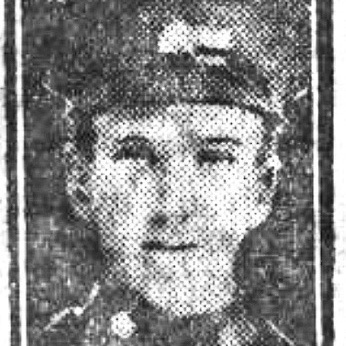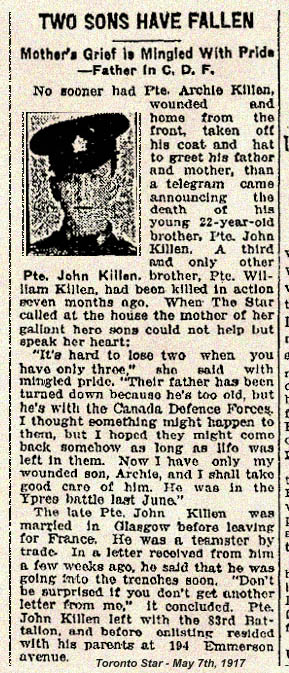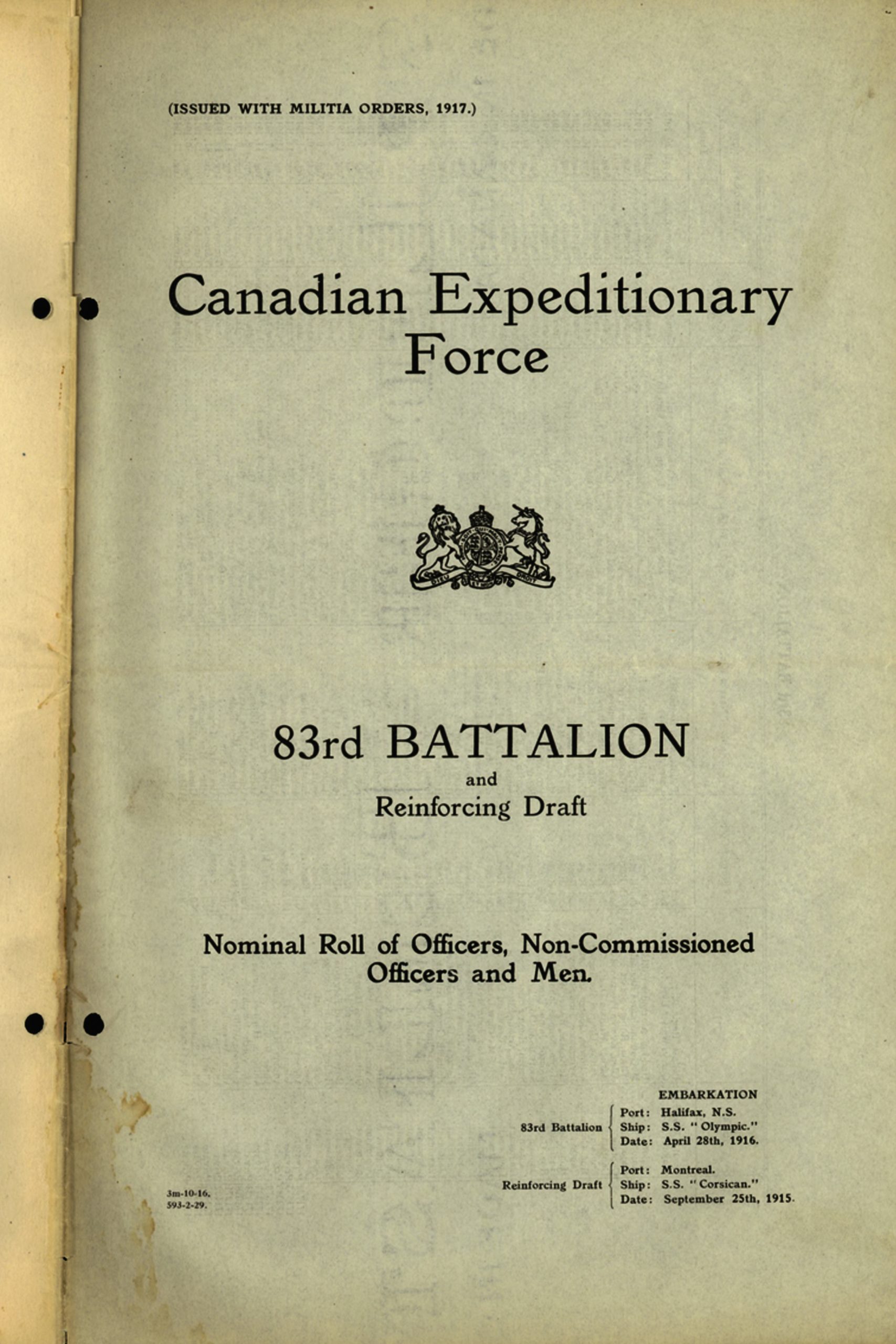Pte. William Killin
1887-1916

Pte. William Killin
Son of James and Catherine Killin, born in Scotland February 10th, 1887, Died September 15th, 1916. Age 29 years.
William was the first of his family to immigrate to Canada and move to Toronto, in 1911. Followed in 1912 by his father (James Bell Killin) and then the rest of his family in 1913. At the age of 28, William was married in Toronto on September 11th, 1915 to Agnes McCrea (born Ayr, Scotland). Brother Archibald was his best man and signed as witness.
About 18 months after William’s reported death in action, Agnes remarried on May 3rd, 1918 to Edwin Thomas Lloyd. Pte. William Killin (# 171145, member of the 4th Canadian Machine Gun Company, 2nd Canadian Division) was killed in Action on September 15th, 1916. KIA during the Somme offensive in France during WWI (The War To End All Wars), (The Great War for Civilization 1914-1918). His remains were reported to have been “buried by Pioneers, South East of Bapaume Road, on a line between Courelette and Martinpuinch.” (Source attached) Pte. William Killin is listed on the Vimy Memorial in France and in the Book of Remembrance held in Ottawa. (Sources attached). He was killed during one of the battles of or around Courcelette. A copy of a painting of these battles is attached to give you some idea of the context of what he encountered. From some of the material attached, it appears that William was hospitalized in France on March 30th, 1916 with Influenza and discharged from hospital back to active duty on April 1st, 1916 (see page # 10 of 36 of William Attestation 1915 file). William enlisted with his two brothers, Archie & John, August 7th, 1915 in Toronto into the 83rd Battalion BEF, 4th Canadian Machine Gun Company (see page # 25 of 28 of Canadian Expeditionary Force, 83rd Battalion and Reinforcement Draft). Also attached are two Toronto news articles that mention William and his brothers. A reference in one of these news articles refers to the three brothers being in the trenches together in the same machine gun company. Attached is a copy of a painting of the battle at Mount Sorrel that will give you an idea of what the three brothers encountered during the action they initially encountered upon entering the war.
Look to the middle of the painting and you will see a group of three men working together working a machine gun. Could this have been the three Killin boys working together? Before William left for War he lived with his family in Toronto at 194 Emerson Ave. Attached is a photo post card sent to William’s brother Archie that shows the family home in 1917 with their Mother, presumably their two sisters and some unknown children. Also attached is a 2019 photo of the same house. Note the tree that in 1917 was a sapling and in 2019 is a mature tree and one of the few on the street.
Reference material Canadian Expeditionary Force, 83rd Battalion and Reinforcement Draft AND William Attestation 1915) 83rd Battalion Background Information Organized in July 1915 under the command of Lieutenant-Colonel R. Pellatt. Authorization published in General Order 103a of 15 August 1915. Mobilized at Toronto. Recruited in Toronto. Draft of 250 sent to England in September 1915. Embarked from Halifax 1 May 1916 aboard OLYMPIC. Disembarked England 6 May 1916. Strength: 35 officers, 1035 other ranks. Draft of 300 to 4th and 5th Canadian Mounted Rifles in June 1916. Draft of 70 to 3rd Battalion in June 1916. Draft of 30 to 19th Battalion in July 1916.
Absorbed by 12th Canadian Reserve Battalion on 7 July 1916. Disbanded by Privy Council Order 1366 and 1863 of 21 May and 6 July 1917. Bugle band. Perpetuated by The Queen’s Own Rifles of Canada. 83rd Battalion (Queen's Own Rifles of Canada), CEF CEF was an infantry battalion of the Canadian Expeditionary Force during the Great War. The 83rd Battalion was authorized on 10 July 1915 and embarked for Britain on 28 April 1916. It provided reinforcements for the Canadian Corps until 7 July 1916, when its personnel were absorbed by the 12th Reserve Battalion, CEF. The battalion was subsequently disbanded on 21 May 1917.[1] The 83rd Battalion recruited in and was mobilized at Toronto, Ontario. [2] The 83rd Battalion was commanded by Lt.-Col. R. Pellatt from 1 May 1916 to 17 August 1916. [3] The 83rd Battalion was awarded the battle honour THE GREAT WAR 1916.[4] The 83rd Battalion, CEF is perpetuated by The Queen's Own Rifles of Canada. [5] References 1. ^ Canadian Forces Publication A-DH-267-003 Insignia and Lineages of the Canadian Forces. Volume 3: Combat Arms Regiments. 2. ^ Meek, John F. Over the Top! The Canadian Infantry in the First World War. Orangeville, Ont.: The Author, 1971. ISBN 0906158109 3. ^ Meek, John F. Over the Top! The Canadian Infantry in the First World War. Orangeville, Ont.: The Author, 1971. ISBN 0906158109 4. ^ Meek, John F. Over the Top! The Canadian Infantry in the First World War. Orangeville, Ont.: The Author, 1971. ISBN 0906158109 5. ^ Canadian Forces Publication A-DH-267-003 Insignia and Lineages of the Canadian Forces. Volume 3: Combat Arms Regiments.
Canadian Expeditionary Force 1914–1919 by Col. G.W.L. Nicholson, CD, Queen's Printer, Ottawa, Ontario, 1962 4th Canadian Machine Gun Company: Guide to Sources Relating to Units of the Canadian Expeditionary Force 6 4th Canadian Machine Gun Company Background Information Organized in Belgium in December 1915 as the 4th Canadian Infantry Brigade Machine Gun Company. Commanded by Captain J. Edwards. Composed of machine gun sections of the 4th Brigade’s infantry battalions. Redesignated as 4th Canadian Machine Gun Company in July 1916. The 4th, 5th, 6th and 14th Canadian Machine Gun Companies were detached from their respective infantry brigades in September 1917 and formed the 4th, 5th, 6th and 14th Companies of the 2nd Canadian Divisional Machine Gun Battalion. Reorganized on 21 March 1918 to form the 2nd Battalion, Canadian Machine Gun Corps. Restored battlefield map of positions occupied on 4 June 1916 The Battle of Mont Sorrel (Battle of Mount Sorrel, Battle of Hill 62) was a local operation in World War I by three divisions of the British Second Army and three divisions of the German 4th Army in the Ypres Salient, near Ypres, Belgium, from 2 to 13 June 1916. To divert British resources from the build-up being observed on the Somme, the XIII (Royal Württemberg) Corps and the 117th Infantry Division attacked an arc of high ground defended by the Canadian Corps. The German forces captured the heights at Mount Sorrel and Tor Top, before entrenching on the far slope of the ridge. Following a number of attacks and counterattacks, two divisions of the Canadian Corps, supported by the 20th Light Division and Second Army siege and howitzer battery groups, recaptured the majority of their former positions.
Son of James and Catherine Killin, born in Scotland February 10th, 1887, Died September 15th, 1916. Age 29 years.
William was the first of his family to immigrate to Canada and move to Toronto, in 1911. Followed in 1912 by his father (James Bell Killin) and then the rest of his family in 1913. At the age of 28, William was married in Toronto on September 11th, 1915 to Agnes McCrea (born Ayr, Scotland). Brother Archibald was his best man and signed as witness.
About 18 months after William’s reported death in action, Agnes remarried on May 3rd, 1918 to Edwin Thomas Lloyd. Pte. William Killin (# 171145, member of the 4th Canadian Machine Gun Company, 2nd Canadian Division) was killed in Action on September 15th, 1916. KIA during the Somme offensive in France during WWI (The War To End All Wars), (The Great War for Civilization 1914-1918). His remains were reported to have been “buried by Pioneers, South East of Bapaume Road, on a line between Courelette and Martinpuinch.” (Source attached) Pte. William Killin is listed on the Vimy Memorial in France and in the Book of Remembrance held in Ottawa. (Sources attached). He was killed during one of the battles of or around Courcelette. A copy of a painting of these battles is attached to give you some idea of the context of what he encountered. From some of the material attached, it appears that William was hospitalized in France on March 30th, 1916 with Influenza and discharged from hospital back to active duty on April 1st, 1916 (see page # 10 of 36 of William Attestation 1915 file). William enlisted with his two brothers, Archie & John, August 7th, 1915 in Toronto into the 83rd Battalion BEF, 4th Canadian Machine Gun Company (see page # 25 of 28 of Canadian Expeditionary Force, 83rd Battalion and Reinforcement Draft). Also attached are two Toronto news articles that mention William and his brothers. A reference in one of these news articles refers to the three brothers being in the trenches together in the same machine gun company. Attached is a copy of a painting of the battle at Mount Sorrel that will give you an idea of what the three brothers encountered during the action they initially encountered upon entering the war.
Look to the middle of the painting and you will see a group of three men working together working a machine gun. Could this have been the three Killin boys working together? Before William left for War he lived with his family in Toronto at 194 Emerson Ave. Attached is a photo post card sent to William’s brother Archie that shows the family home in 1917 with their Mother, presumably their two sisters and some unknown children. Also attached is a 2019 photo of the same house. Note the tree that in 1917 was a sapling and in 2019 is a mature tree and one of the few on the street.
Reference material Canadian Expeditionary Force, 83rd Battalion and Reinforcement Draft AND William Attestation 1915) 83rd Battalion Background Information Organized in July 1915 under the command of Lieutenant-Colonel R. Pellatt. Authorization published in General Order 103a of 15 August 1915. Mobilized at Toronto. Recruited in Toronto. Draft of 250 sent to England in September 1915. Embarked from Halifax 1 May 1916 aboard OLYMPIC. Disembarked England 6 May 1916. Strength: 35 officers, 1035 other ranks. Draft of 300 to 4th and 5th Canadian Mounted Rifles in June 1916. Draft of 70 to 3rd Battalion in June 1916. Draft of 30 to 19th Battalion in July 1916.
Absorbed by 12th Canadian Reserve Battalion on 7 July 1916. Disbanded by Privy Council Order 1366 and 1863 of 21 May and 6 July 1917. Bugle band. Perpetuated by The Queen’s Own Rifles of Canada. 83rd Battalion (Queen's Own Rifles of Canada), CEF CEF was an infantry battalion of the Canadian Expeditionary Force during the Great War. The 83rd Battalion was authorized on 10 July 1915 and embarked for Britain on 28 April 1916. It provided reinforcements for the Canadian Corps until 7 July 1916, when its personnel were absorbed by the 12th Reserve Battalion, CEF. The battalion was subsequently disbanded on 21 May 1917.[1] The 83rd Battalion recruited in and was mobilized at Toronto, Ontario. [2] The 83rd Battalion was commanded by Lt.-Col. R. Pellatt from 1 May 1916 to 17 August 1916. [3] The 83rd Battalion was awarded the battle honour THE GREAT WAR 1916.[4] The 83rd Battalion, CEF is perpetuated by The Queen's Own Rifles of Canada. [5] References 1. ^ Canadian Forces Publication A-DH-267-003 Insignia and Lineages of the Canadian Forces. Volume 3: Combat Arms Regiments. 2. ^ Meek, John F. Over the Top! The Canadian Infantry in the First World War. Orangeville, Ont.: The Author, 1971. ISBN 0906158109 3. ^ Meek, John F. Over the Top! The Canadian Infantry in the First World War. Orangeville, Ont.: The Author, 1971. ISBN 0906158109 4. ^ Meek, John F. Over the Top! The Canadian Infantry in the First World War. Orangeville, Ont.: The Author, 1971. ISBN 0906158109 5. ^ Canadian Forces Publication A-DH-267-003 Insignia and Lineages of the Canadian Forces. Volume 3: Combat Arms Regiments.
Canadian Expeditionary Force 1914–1919 by Col. G.W.L. Nicholson, CD, Queen's Printer, Ottawa, Ontario, 1962 4th Canadian Machine Gun Company: Guide to Sources Relating to Units of the Canadian Expeditionary Force 6 4th Canadian Machine Gun Company Background Information Organized in Belgium in December 1915 as the 4th Canadian Infantry Brigade Machine Gun Company. Commanded by Captain J. Edwards. Composed of machine gun sections of the 4th Brigade’s infantry battalions. Redesignated as 4th Canadian Machine Gun Company in July 1916. The 4th, 5th, 6th and 14th Canadian Machine Gun Companies were detached from their respective infantry brigades in September 1917 and formed the 4th, 5th, 6th and 14th Companies of the 2nd Canadian Divisional Machine Gun Battalion. Reorganized on 21 March 1918 to form the 2nd Battalion, Canadian Machine Gun Corps. Restored battlefield map of positions occupied on 4 June 1916 The Battle of Mont Sorrel (Battle of Mount Sorrel, Battle of Hill 62) was a local operation in World War I by three divisions of the British Second Army and three divisions of the German 4th Army in the Ypres Salient, near Ypres, Belgium, from 2 to 13 June 1916. To divert British resources from the build-up being observed on the Somme, the XIII (Royal Württemberg) Corps and the 117th Infantry Division attacked an arc of high ground defended by the Canadian Corps. The German forces captured the heights at Mount Sorrel and Tor Top, before entrenching on the far slope of the ridge. Following a number of attacks and counterattacks, two divisions of the Canadian Corps, supported by the 20th Light Division and Second Army siege and howitzer battery groups, recaptured the majority of their former positions.














